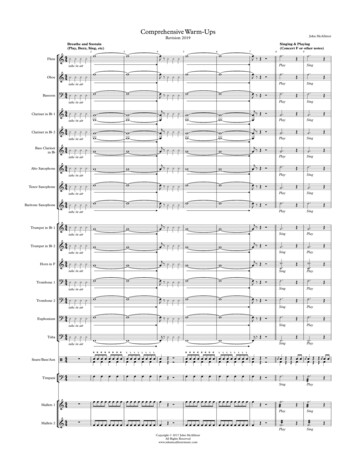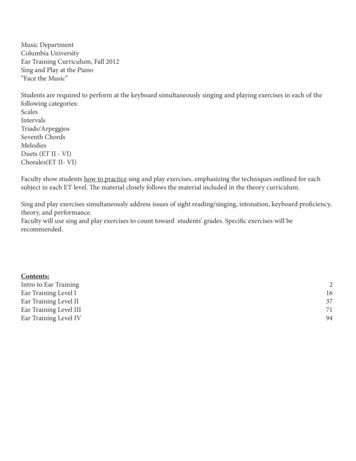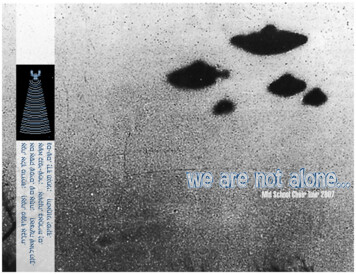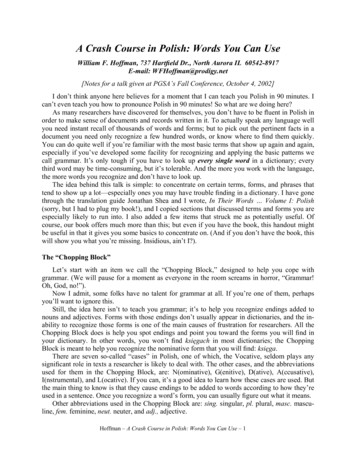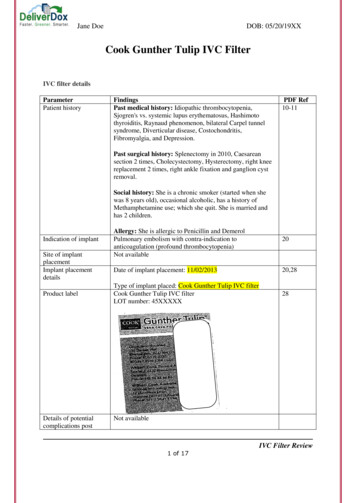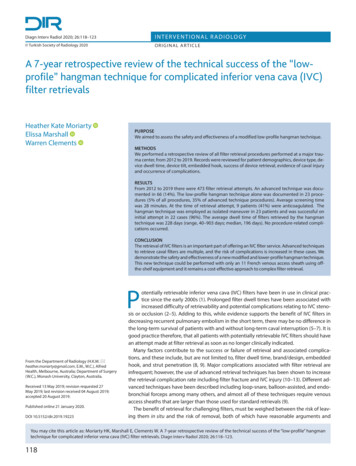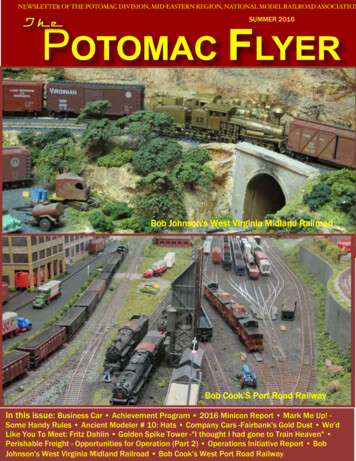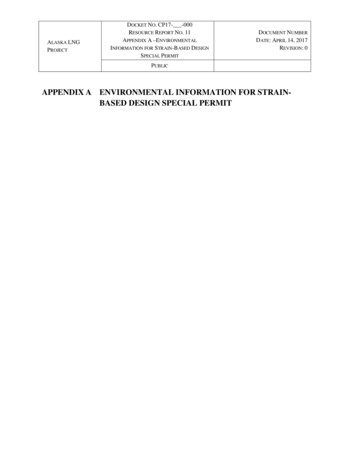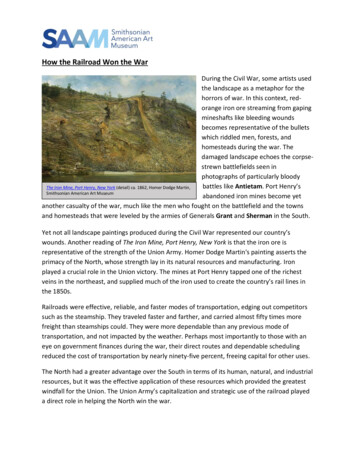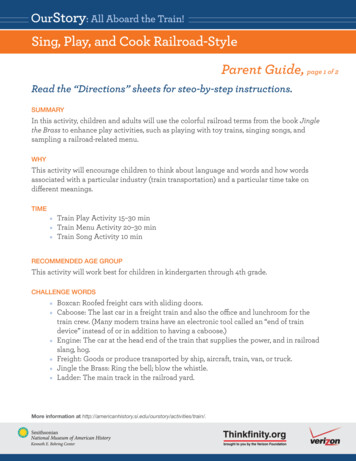
Transcription
OurStory: All Aboard the Train!Sing, Play, and Cook Railroad-StyleParent Guide, page 1 of 2Read the “Directions” sheets for steo-by-step instructions.SUMMARYIn this activity, children and adults will use the colorful railroad terms from the book Jinglethe Brass to enhance play activities, such as playing with toy trains, singing songs, andsampling a railroad-related menu.WHYThis activity will encourage children to think about language and words and how wordsassociated with a particular industry (train transportation) and a particular time take ondifferent meanings.TIME Train Play Activity 15–30 minTrain Menu Activity 20–30 minTrain Song Activity 10 minRECOMMENDED AGE GROUPThis activity will work best for children in kindergarten through 4th grade.CHALLENGE WORDS Boxcar: Roofed freight cars with sliding doors.Caboose: The last car in a freight train and also the office and lunchroom for thetrain crew. (Many modern trains have an electronic tool called an “end of traindevice” instead of or in addition to having a caboose.)Engine: The car at the head end of the train that supplies the power, and in railroadslang, hog.Freight: Goods or produce transported by ship, aircraft, train, van, or truck.Jingle the Brass: Ring the bell; blow the whistle.Ladder: The main track in the railroad yard.More information at train/.
OurStory: All Aboard the Train!Sing, Play, and Cook Railroad-StyleParent Guide, page 2 of 2 Assemble: to connect or put together the parts of (something, such as a toy ormachine).Adapt: to change (something) so that it functions better or is better suited for apurpose.GET READY Read Patricia Newman’s book Jingle the Brass together. Jingle the Brass is a bookabout a young boy who learns words used by railroad workers of the steam-engineera while on a train trip. For tips on reading this book together, check out theGuided Reading Activity train reading.pdf).Read the Step Back in Time sheet.YOU NEED Talk Together Tips sheets (attached)Step Back in Time sheets (attached)Computer with Internet access (video at html)Speakers or headphonesMore information at train/.
OurStory: All Aboard the Train!Sing, Play, and Cook Railroad-StyleStep Back in Time, page 1 of 2For more information, visit the National Museum of American History Web ies/train/.Railroads have moved people and cargoaround America for more than 180 years.The first steam-powered locomotives began toappear around 1830, and were very important toland transportation by the 1850s. By 1860, therewere roughly 31,000 miles of track in the country,mostly in the Northeast, but also in the South andMidwest.The “John Bull” was one of the firstsuccessful locomotives in the United States.It ran for the first time in November, 1831.As the rail system grew, it connected the lives ofAmericans across the country. By 1893, almostany town could receive food and goods from any section of the country within a weekor two. In the 1920s, trains delivered daily mail and express packages andlong-distance travel was available to even more people.Facts and FictionThe words and illustrations in Jinglethe Brass represent a mix of fantasyand facts about steam locomotives inAmerican history. For example, theillustrations of hobos are comical andin general practice a child would notride in the cab of a locomotive. Forreaders interested in “just the facts,”we recommend the nonfiction bookThe John Bull: A British LocomotiveComes to America by DavidWeitzman.From the 1830s through the 1950s, peopletraveled in trains pulled by steam locomotives.Cars in these trains were almost alwaysarranged in a specific order. Coal-burningsteam engines sent smoke and cinders into theair, so the most privileged passengers sat asfar away from the locomotive as possible. Thepassenger cars—the coaches—were separatedfrom the locomotive by the mail and baggagecars.
OurStory: All Aboard the Train!Sing, Play, and Cook Railroad-StyleStep Back in Time,page 2 of 2It took many people to make the railroad system work.The conductor was the “captain” of the train; he was in charge of the train crew,looked out for the safety of everyone aboard, and made sure that every passenger paidthe correct fare. Two crew members worked in the engine’s cab: the engineer ran the locomotive,and the fireman managed the boiler and helped watch for signals. Both jobs werehighly skilled. On trains with luxurious sleeping cars, people called “Pullman Porters” tookcare of passengers’ needs, like helping with luggage and tidying up the passengerarea. Other “behind the scenes” railroad workers included the business clerks, trackworkers, signal tower workers, and express package agents. The railroads that cross the country, mostly because of the food, coal, cars, and othergoods that travel by rail, still have an impact on our lives. Many Americans still travelby rail, on diesel-powered locomotives, streetcars, subways, and commuter trains.For more information, visit the America on the Move online exhibition ive: the vehicle that produces the power that pulls a train.Cinders: very small pieces of burned material, such as wood or coal.Privileged: having special rights or advantages that most people do not have, such as money.Luxurious: very comfortable and expensive.Diesel: a specific type of oil fuel.Commuter trains: trains that carry travelers regularly to and from places, especially between theirhomes and workplaces.
OurStory: All Aboard the Train!Sing, Play, and Cook Railroad-StyleDirections, page 1 of 6Train Play ActivityTake a close look at your train engine. See if itlooks like a steam or diesel engine. A steamengine would have a smoke stack orchimney tube and should be attached to atender car carrying water and fuel. A dieselengine has a “dog-nose” shape front. Take alook at the picture to the right for anexample of a steam locomotive (left) next toa diesel locomotive (right).Diesel locomotive (right) brings the SouthernRailway’s “Tennessean” passenger train intoHarrisonburg, Virginia, 1947 National Museumof American History, Transportation Collections,McBride photosAs you are playing with your trains, try to use these words from Jingle the Brass.o When should your conductor “jingle the brass”?o What kinds of cars are on your train? Do you have a “hog,” “caboose,” “reefer,” or“snoozer?” What goods or people would go inside each of those cars?o Are there tunnels? When would the brakeman feel the “telltales”?Try to make your trains look like the scenes in Jingle the Brass.o If you have a steam locomotive, where would it fill up on water, like on page 9?o Do your trains ever need to “pull off the main line” or “lie dead” to let other trainspass?Imagine what people might be a part of your train’s story.o Where would your conductor ride? Would your train have passengers? Is there an“ashcat” on your train?o Are all of the tracks in top condition? Where might the “gandy dancers” beworking?TipFor extra fun, sing together like the track workers!
OurStory: All Aboard the Train!Sing, Play, and Cook Railroad-StyleDirections, page 2 of 6Train Menu ActivityUsing Jingle the Brass vocabulary and theglossary of definitions from the back of thebook, re-write the breakfast menu on the nextpage. This menu is one that is used on one oftoday’s Amtrak Cross Country Café Tours.The Cross Country Café offers a uniqueonboard experience on the trains City of NewOrleans and Texas Eagle that includes thetastes of the regions.Dining car on the B&O Railroad's CapitolLimited, June 12, 1925Smithsonian Institution, Negative #: 77-7595Old Fashioned Railroad Food Terms:Bait Can or Nosebag: Lunch bucket or bag.Put on the nosebag: To eat.Beanery: A railroad eating house.Rolling Stock or sinkers: Donuts.Beanery Queen: Waitress.Torpedoes: Green beans.Diner: The dining car on a passenger train.Whitewash: Milk.Eggs with headlights: Eggs sunny-side up.Wreck on the main line: Scrambled eggs.Jailhouse spuds: Waffled potatoes.Some of the items on the menu below don’t have a definition found in the Jingle theBrass glossary. Think about how the terms above create a picture in your mind.Can you create some “railroad” lingo for the following: French toast, biscuits,bacon, or a sausage patty?Next, using your railroad terminology, decide what you will eat and place yourbreakfast order with the beanery queen.
OurStory: All Aboard the Train!Sing, Play, and Cook Railroad-StyleDirections, page 3 of 6Train Menu Activity (continued)Sample Children’s Menu on the City of New Orleans TrainScrambled Eggs (Served with breakfast potatoes or grits, small croissant or warmbiscuit)Railroad French Toast (Traditional thick slices of egg-batter-dipped toast, grilled to agolden brown and served with syrup, berry topping and dusted with powderedsugar)Breakfast MeatsPork Sausage – One PattyBacon – Two StripsTipFor more fun, cook part of the railroad menu together. While you’recooking, take a look at the packages your food came in. Can you tell wherethe foods were grown or packed? Which ones might have traveled bytrain?
OurStory: All Aboard the Train!Sing, Play, and Cook Railroad-StyleDirections, page 4 of 6Train Songs ActivitySongs are a great way to explore life on the railroads! Take a look at these two songs.“I’ve Been Working on the Railroad”Traditional Songhttp://www.folkways.si.edu/listen2.aspx?type preview&trackid 8760I’ve been working on the railroadAll the live long day,I’ve been working on the railroad,Just to pass the time away;Can’t you hear the whistle blowing?Rise up so early in the morn;Don’t you hear the captain shouting?Dinah blow your horn.According to the song, what does the whistle sound mean? (“Rise up so early” meansit is the alarm to wake up the workers.) How do you wake up in the morning?What jobs do your friends and family have? What words would be important to writea song about their jobs?For more activities about trains in American history and Jingle the Brass, ties/train/).
OurStory: All Aboard the Train!Sing, Play, and Cook Railroad-StyleDirections, page 5 of 6Train Songs Activity (Continued)“Chattanooga Choo Choo”by Glenn o.mp3Pardon me, boyIs that the Chattanooga choo choo?Track twenty-nineBoy, you can gimme a shineI can affordTo board a Chattanooga choo chooI've got my fareAnd just a trifle to spareYou leave the Pennsylvania Station ‘bout a quarter to fourRead a magazine and then you're in BaltimoreDinner in the dinerNothing could be finerThan to have your ham an' eggs in CarolinaWhen you hear the whistle blowin’ eight to the barThen you know that Tennessee is not very farShovel all the coal inGotta keep it rollin’Woo, woo, Chattanooga there you areThere’s gonna beA certain party at the stationSatin and laceI used to call “funny face”She's gonna cryUntil I tell her that I'll never roamSo Chattanooga choo chooWon't you choo-choo me home?Chattanooga choo chooWon't you choo-choo me home?
OurStory: All Aboard the Train!Sing, Play, and Cook Railroad-StyleDirections, page 6 of 6Train Songs Activity (Continued)Listen for all of the different locations mentioned in the song. Find them on a map. Ifyou look at the song’s lyrics in order, can you tell if the train is traveling north orsouth?The word “choo choo” is an onomatopoeia, or the creation of words that imitatenatural sounds (like “buzz” and “hiss”). What part of a steam-powered train soundslike “choo choo?” If you were going to write a song about a car, boat, or airplane,what onomatopoeia might you use?TipTo see and hear a steam train in action, watch a video of the John Bulllocomotive at .html).Most modern trains are diesel-powered, not steam-powered, so they sounddifferent. The “choo-choo” sound was typical of the whistles onsteam-powered locomotives.For more activities about trains in American history and Jingle the Brass, ties/train/).
OurStory: All Aboard the Train!Sing, Play, and Cook Railroad-StyleFor TeachersRead the “Parent Guide” and “Directions” sheets for specificinstructions.OBJECTIVESThe students will be better able to: Discuss and understand how vocabulary and expressions can be specific to aparticular activity or industry.Discuss what it would be like to ride or work on a steam train.STUDENT PERFORMANCE CRITERIA Successfully use vocabulary and expressions from Jingle the Brass accurately andappropriately while at play.STANDARDSIRA/NCTE Language Arts Standards1. Students read a wide range of print and non-print texts to build an understanding oftexts, of themselves, and of the cultures of the United States and the world; toacquire new information; to respond to the needs and demands of society and theworkplace; and for personal fulfillment. Among these texts are fiction andnonfiction, classic and contemporary works.4. Students adjust their use of spoken, written, and visual language (e.g., conventions,style, vocabulary) to communicate effectively with a variety of audiences and fordifferent purposes.9. Students develop an understanding of and respect for diversity in language use,patterns, and dialects across cultures, ethnic groups, geographic regions, and socialroles.12. Students use spoken, written, and visual language to accomplish their own purposes(e.g., for learning, enjoyment, persuasion, and the exchange of information).More information at train/.
Eggs with headlights: Eggs sunny-side up. Wreck on the main line: Scrambled eggs. Jailhouse spuds: Wa ed potatoes. Some of the items on the menu below don’t have a definition found in the Jingle the Brass glossary. Think
